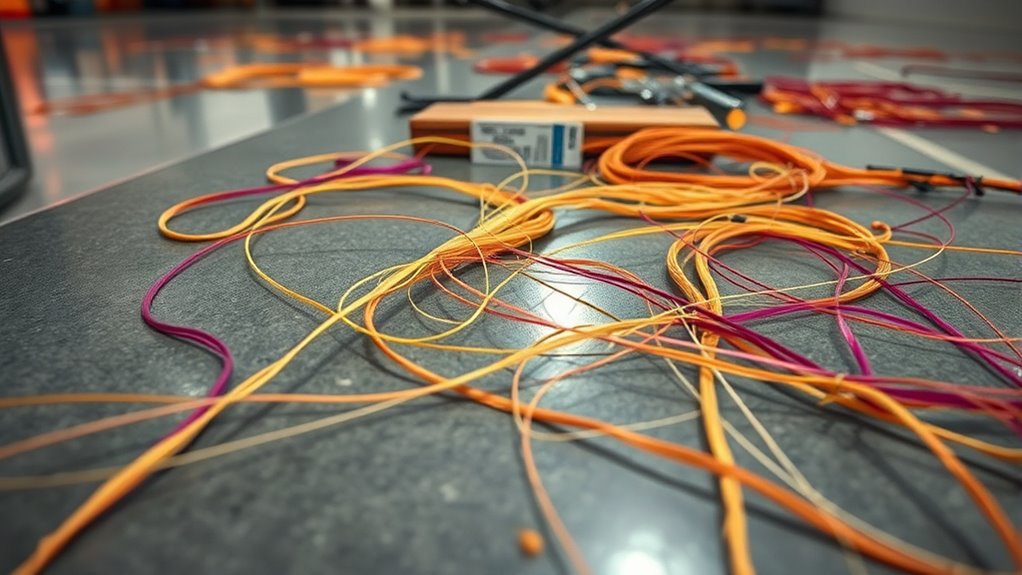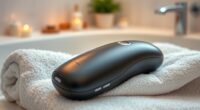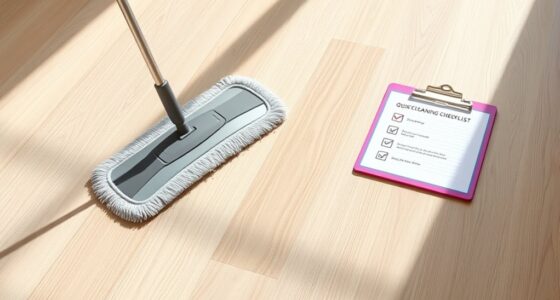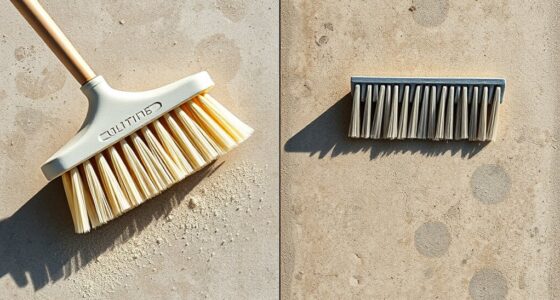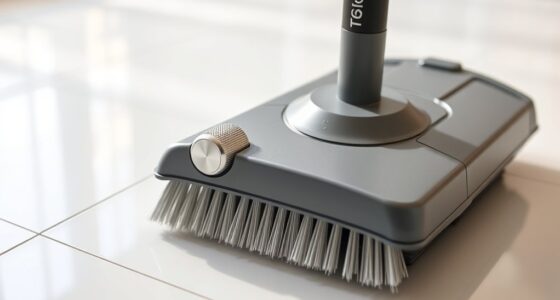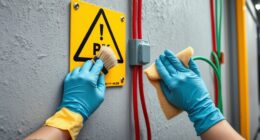To remove hair and string from your garage floor without causing jams, start by sweeping the area with a stiff-bristled broom to loosen debris. Follow up with a shop vacuum to pick up small fibers, strands, and stubborn bits carefully. Avoid using a wet mop that can push fibers into cracks, and handle tangled debris with scissors or a utility knife for precision. Keep safety in mind, and you’ll prevent jams—more tips await if you continue exploring these easy, effective methods.
Key Takeaways
- Use a sturdy broom to sweep hair and string into a dustpan, focusing on edges and corners.
- Follow with a shop vacuum to pick up remaining fibers and strands without scattering debris.
- For stubborn tangled debris, carefully cut or pry with scissors or a utility knife in well-lit areas.
- Avoid damp mops; instead, dry clean with brushes and vacuums to prevent pushing debris into cracks.
- Regularly maintain the floor with sweeping and vacuuming to prevent buildup of hair and string.
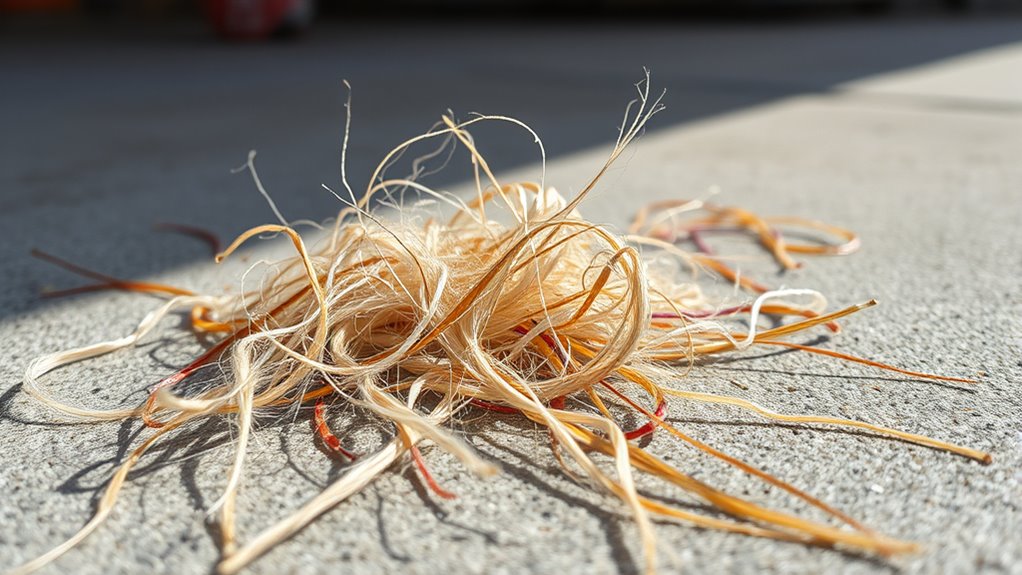
Keeping hair and string off your garage floor can be a constant struggle, especially if you use the space for projects or parking. These materials tend to get tangled in the cracks or stuck in corners, making cleanup frustrating. Fortunately, there are effective cleaning techniques you can use that don’t involve harsh chemicals or complicated tools. The key is to approach the task with safety precautions in mind, so you avoid injuries or damaging your garage floor.
Keeping garage floors clean of hair and string is easier with safe sweeping and vacuuming techniques.
Start by gathering your cleaning supplies: a pair of gloves, a broom or dustpan, a shop vacuum, and a pair of scissors or a utility knife. Wearing gloves protects your hands from dirt, debris, or sharp objects that might be hidden in the mess. When you sweep the area, use a broom with sturdy bristles to loosen the hair and string from the surface. Be thorough, sweeping along the edges and into the corners where debris tends to accumulate. Once you’ve swept up the loose mess, use a shop vacuum to pick up any remaining fibers or small strands. This step ensures you remove even the tiniest pieces that can reattach or cause further mess.
For stubborn hair or string that’s tangled in cracks or stuck to uneven surfaces, a pair of scissors or a utility knife can be invaluable. Carefully cut or pry away the debris, being cautious not to scratch or gouge your garage floor. Always prioritize safety precautions: work in a well-lit area, keep sharp tools away from children or pets, and avoid rushing the process. If you notice any oil spills or sticky residues, clean those areas with a mild degreaser or soap and water before proceeding with hair removal—this prevents slipping and keeps the floor safe. Incorporating proper cleaning tools can significantly enhance your efficiency and protect your garage surface.
To prevent future buildup, consider applying a protective sealant to your garage floor, which can make cleaning easier and reduce the adhesion of fibers and debris. Regular maintenance is essential; set a schedule to sweep and vacuum your floor weekly, especially if you work on projects that generate lots of fibers or debris. When removing hair and string, avoid sweeping with a broom that might scatter the debris further or using a damp mop that can push the fibers into cracks. Instead, stick to dry cleaning methods and safe tools to keep the process quick and effective.
Frequently Asked Questions
Can This Method Be Used on Delicate or Painted Garage Floors?
Yes, you can use this method on delicate surfaces and painted floors, but you should proceed with caution. Test it in a small, hidden area first to verify it won’t damage the paint or finish. Avoid excessive force and use gentle tools to prevent scratches or peeling. If your garage floors are especially delicate or freshly painted, consider consulting a professional to avoid any potential damage.
How Long Does the Removal Process Typically Take?
The removal process usually takes about 10 to 20 minutes, depending on how much hair or string is on your garage floor. You can expect a steady removal speed if you follow the method correctly. Keep in mind that timing expectations may vary if the debris is tangled or stubborn. Staying patient and working carefully will help speed up the process and guarantee a clean, damage-free floor.
Are There Any Safety Precautions I Should Follow?
Did you know that over 60% of DIY injuries happen due to neglecting safety precautions? When removing hair and string from garage floors, always wear protective gear like gloves and goggles to prevent irritation or injury. Make certain good ventilation to avoid inhaling dust or fumes. These simple steps keep you safe and make the process smoother, so don’t skip them—your safety should always come first.
Will This Method Damage Existing Floor Coatings?
This method is safe for your floor coatings if you check for compatibility first. Confirm your surface prep requirements are met by cleaning thoroughly and removing debris. If your floor coating is compatible and properly prepared, the no-jam removal technique won’t damage it. Always verify with the coating manufacturer or a professional if you’re unsure about compatibility, and follow recommended surface prep procedures to protect your finish.
Is This Technique Effective for Large Amounts of Hair and String?
When tackling large amounts of hair and string, it’s best to think big or go home. This technique is quite effective for hair cleanup and string removal, even in bulk. It grips and lifts debris efficiently without damaging your garage floor. Just be patient and thorough; it’s designed to handle substantial messes. You’ll find that this method saves time and effort, making cleanup less of a chore.
Conclusion
Now that you know this simple, no-jam removal method, imagine how smooth your garage floor will stay—no more frustrating tangles or stubborn hair and string. But here’s the catch: what if the next time you walk in, something unexpected awaits? Stay prepared, because with this trick up your sleeve, you’re always one step ahead. Ready to keep your garage spotless and surprises at bay? The solution’s just a quick move away—don’t wait to find out!
